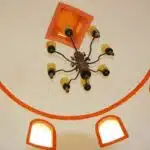A blanket ladder is a practical and stylish addition to any home. It not only provides a convenient storage solution for blankets and throws but also adds charm and character to an otherwise ordinary room. Building your own blanket ladder is an excellent way to save money while unleashing your creativity.
In this article, we will guide you through the process of building a blanket ladder step-by-step. You don’t need extensive woodworking experience or fancy tools to construct one. We’ll provide you with all the necessary instructions, including materials needed, measurements, and safety tips. By the end of this article, you’ll have a beautiful and functional piece of furniture that will enhance the look of your home while providing warmth and comfort to those around you.
Choosing The Right Materials
As the saying goes, “measure twice, cut once.” This adage is particularly true when it comes to building a blanket ladder. The first step in constructing a sturdy and reliable ladder is selecting the right materials. The type of wood you choose can significantly impact the strength, durability, and overall appearance of your finished product.
When it comes to selecting wood for your blanket ladder, there are several options available. Some popular choices include pine, oak, maple, and poplar. Pine is an affordable option that is easy to work with but may not be as strong as other types of wood. Oak and maple are hardwoods that are known for their durability and strength but come with a higher price tag. Poplar is another excellent choice for those on a budget as it has many of the same properties as hardwoods but at a more affordable cost.
Cost considerations are also essential when choosing materials for your blanket ladder project. While some woods may be more expensive than others, it’s important to think about the long-term value of your investment. A quality ladder made from durable materials will last much longer than one made from cheaper alternatives. Additionally, investing in high-quality materials can ensure that your finished product looks professional and aesthetically pleasing.
Choosing the right types of wood and considering cost factors are crucial steps in building a blanket ladder that will last for years to come. Once you’ve selected your desired wood type, measuring and cutting the wood is the next critical step in completing this DIY project successfully.
Measuring And Cutting The Wood
Now that you have chosen the right materials for your blanket ladder, it’s time to move on to the next step: measuring and cutting the wood. This is an important stage of your project as measuring accuracy will determine how well the ladder fits together. To ensure precision, use a tape measure and mark the measurements with a pencil. Be precise when marking the wood, as this will help avoid mistakes when cutting.
When it comes to cutting techniques, there are several options available. You can use a handsaw or a circular saw depending on what is available to you. If you are using a handsaw, make sure it is sharp enough to make clean cuts without splintering or damaging the wood. On the other hand, if you prefer using a circular saw, ensure that the blade is sharp and aligned correctly before making any cuts.
Measuring accuracy and cutting techniques are crucial in building your blanket ladder. Take your time when measuring and marking your wood pieces to avoid costly mistakes during cutting. Once you have successfully measured and cut all necessary pieces for your project, proceed to sanding and finishing the ladder for a smooth surface finish.
Sanding And Finishing The Ladder
Once you have cut the wood and assembled the ladder frame, it is time to sand and finish your blanket ladder. Sanding is an important step in the finishing process as it smoothens out any rough edges or splinters that could cause harm while handling the ladder. For this task, you will need sanding tools such as a handheld sander or sandpaper.
Begin by using a coarse grit sandpaper to remove any rough spots or blemishes on the wood. Start with a lower grit number and work your way up gradually until you achieve a smooth surface. Once you have sanded all parts of the ladder, switch to a fine-grit sandpaper to give it a polished look.
After sanding, it is time to apply stain or paint to the wood. Staining techniques come in different forms, from wiping stains to brushing stains, and each has its own application method. Choose one that suits your preference and apply it with even strokes across the surface of the wood. Allow for ample drying time before proceeding with assembling the ladder rungs.
Transition into subsequent section: With your blanket ladder now sanded and finished, it’s time to move onto another critical step – assembling the ladder rungs.
Assembling The Ladder Rungs
As the old saying goes, “measure twice, cut once.” This is especially true when it comes to assembling the ladder rungs for your blanket ladder. Take your time and ensure that everything lines up properly before making any cuts.
Spacing options for the rungs will depend on personal preference and the size of the blankets you plan to hang. A general rule of thumb is to space them 12-18 inches apart. Be sure to mark where each rung will go before drilling any holes.
Different rung materials can be used depending on the desired aesthetic and strength needed for your ladder. Popular options include wood dowels, metal pipes or rods, or even repurposed wooden branches for a rustic look. Consider weight capacity as well when selecting materials.
Next, we’ll discuss how to attach the rungs to the ladder sides without compromising stability or safety.
Attaching The Rungs To The Ladder Sides
Once you have cut your ladder sides and rungs to size, it’s time to attach them. Here are some spacing suggestions to consider before attaching your rungs. Keep in mind that the spacing of the rungs depends on how you intend to use the ladder. If you want to display thicker blankets, then it may be necessary to space them further apart.
| Rung Spacing | Recommended Usage |
|---|---|
| 8 inches | Lightweight throws |
| 12 inches | Medium-weight |
| 16 inches | Heavyweight |
| 20 inches | Thick blankets |
| Custom | Personal preference |
To attach the rungs, place one of your ladder sides on a flat surface with the narrower edge facing up. Take a rung and place it at your desired height, ensuring that it is perpendicular to the side and flush with its edges. Use a drill or screwdriver to insert two screws into each end of the rung, securing it in place. Repeat this process for all remaining rungs on both sides of the ladder.
If you want a different look or need an alternative option for your rungs, there are plenty of materials you can use instead of wood. You could try using metal piping or even repurpose old belts as alternative options for a unique touch. Just ensure that they can support the weight of your intended blankets before attaching them.
Now that your blanket ladder has sturdy rungs attached securely, it’s time to add some decorative accents. This can include paint or stain for a personalized touch, or even incorporating some hooks onto the sides for added functionality. With these additions, not only will your new blanket ladder serve its purpose practically but also elevates any room’s overall aesthetic appeal!
Adding Decorative Accents
After attaching the rungs to the ladder sides, it’s time to add some decorative accents that will make your blanket ladder stand out. One way of doing this is by mixing textures. You can use different materials such as rope or twine to wrap around the rungs, which not only adds visual interest but also provides extra grip for holding blankets in place. Another idea is to attach small hooks or knobs on the sides of the ladder where you can hang small decor pieces like plants or picture frames.
When adding decorative accents, it’s important to consider color coordination. You want your ladder to look cohesive and match with the rest of your decor. If you’re using a natural wood finish for your ladder, consider adding pops of color through the accents you choose, such as colorful rope or painted hooks. Alternatively, if you’ve painted your ladder a certain color, choose accents that complement it well.
Next up is painting or staining the ladder, which will give it a finished look and protect it from wear and tear. Before starting this step, make sure all surfaces are clean and dry. If you’re staining the wood, start with a light coat and let it dry completely before applying additional coats until you reach your desired color intensity. For painting, use a brush or roller to apply even coats of paint and let each coat dry before applying another coat. Once done, let everything dry completely before using your new blanket ladder!
Painting Or Staining The Ladder
- When choosing paint or stain for a blanket ladder, homeowners should consider the desired aesthetic, the material of the ladder, and the degree of protection the paint or stain will provide.
- Preparing the ladder for painting or staining includes sanding it down to ensure a smooth finish, cleaning and degreasing it, and removing any hardware.
- Before painting, homeowners should prime the ladder, then apply two coats of paint, waiting for the first coat to dry before applying the second.
- Staining the ladder may require pre-conditioning, depending on the type of wood, and the stain should be applied with a brush or a roller.
- To ensure even coverage when painting, homeowners should use long strokes in the same direction, and when staining, use a circular motion to help the stain penetrate the wood evenly.
- Finally, for both painting and staining, homeowners should apply a protective sealant to protect the ladder from water and wear.
Choosing Paint/Stain
When it comes to painting or staining a blanket ladder, choosing the right color options and DIY paint/stain recipes can make all the difference in achieving the desired look. The first step is to decide on the type of finish that best suits your taste and style. For a more rustic look, consider using a stain that brings out the natural wood grain, while a bold colored paint adds a modern touch.
Next, consider the color palette of the room where the ladder will be displayed. A neutral stain or paint color may work well with any decor scheme, while bolder colors can add a pop of personality to a space. DIY paint/stain recipes are also an option for those looking to create their own unique hue. Be sure to research and test these recipes before applying them to ensure they produce the desired results.
Ultimately, when choosing paint or stain for your blanket ladder, it’s important to take into account both your personal style and the overall aesthetic of your home. With so many color options and DIY recipes available, there’s no shortage of ways to customize your ladder to fit your specific preferences. Take some time to experiment with different finishes until you find one that truly speaks to you.
Preparing The Ladder
Before painting or staining a blanket ladder, it’s important to prepare the ladder for the finishing process. This involves sourcing materials such as sandpaper, wood filler, and a cleaning solution. Sandpaper is used to smooth out any rough spots on the ladder and create a surface that will hold paint or stain. Wood filler can be used to fill in any cracks or holes in the ladder before sanding. A cleaning solution is also necessary to remove any dirt or debris from the surface of the ladder.
Safety considerations should also be taken when preparing the ladder for painting or staining. It’s important to wear protective gear such as gloves and eye protection when using sandpaper and wood filler. The cleaning solution should also be handled with care and kept away from children and pets. Additionally, make sure to work in a well-ventilated area when applying any type of finish to prevent inhalation of harmful fumes.
Once you have sourced your materials and taken necessary safety precautions, you can begin preparing your ladder for painting or staining. Start by sanding the entire surface of the ladder until it is smooth to the touch. Use wood filler to fill in any cracks or holes in the wood, then sand again once dry. Finally, clean the surface of the ladder with a damp cloth and allow it to dry completely before moving on to painting or staining. By properly preparing your ladder, you can ensure that your paint or stain adheres evenly and lasts for years to come.
Painting/Staining Techniques
After preparing the ladder for painting or staining, it’s time to move on to the actual application of paint or stain. One common question is whether to use a sponge or a brush for applying the finish. Both options have their pros and cons. A sponge allows for quick and even coverage, while a brush can provide more control and precision. Ultimately, the choice will depend on personal preference and the type of finish being used.
For those looking to achieve a distressed or vintage look with their ladder, there are several techniques that can be employed during painting or staining. One option is to apply a base coat of paint or stain, allow it to dry completely, then lightly sand certain areas to reveal the wood underneath. Another technique is to use a dry brush method, which involves dipping a brush in paint or stain and then wiping most of it off before applying in short strokes over the surface of the ladder. This creates a textured, weathered effect.
Regardless of the technique used, it’s important to follow all manufacturer instructions when applying paint or stain to your ladder. This includes ensuring proper ventilation during application and allowing ample drying time between coats. By taking care during this step in the process, you can achieve a beautiful finished product that will add both function and style to any room in your home.
Applying A Protective Finish
Imagine a blanket ladder that is not only functional but also visually appealing. You’ve put in the time and effort to construct it, but now you need to ensure its longevity. Choosing the right finish is crucial to protect your blanket ladder from wear and tear.
When selecting a finish for your blanket ladder, consider one that complements the surrounding decor while providing optimal protection. Polyurethane is an excellent choice as it creates a durable barrier between the wood and outside elements. However, if you prefer a more natural look, linseed oil or beeswax can be used.
Common finishing mistakes to avoid include applying too much finish at once, not allowing enough drying time between coats, and failing to sand between coats. These mistakes may result in an uneven or tacky surface, compromising the overall appearance of your project.
To ensure your blanket ladder lasts for years to come, follow these simple tips:
- Apply thin layers of finish
- Thinner layers allow for better absorption by the wood
- Prevents drips or bubbles from forming
- Sand between coats
- Smooths out any rough spots or bubbles
- Allows for better adhesion of subsequent coats
By taking the necessary precautions when applying a protective finish, you can preserve both the function and beauty of your blanket ladder. But before we dive into these safety measures, let’s first address some essential preparation steps.
Safety Precautions
Safety Precautions:
Building a blanket ladder is an exciting and fulfilling project that requires a lot of patience and attention to detail. However, it’s essential to keep safety in mind throughout the entire process. Common injuries associated with building ladders include cuts, bruises, and falls. To avoid these injuries, always wear appropriate safety equipment like gloves, goggles, and sturdy shoes.
The importance of following safety guidelines cannot be overstated. Before starting the project, make sure to read and understand all instructions carefully. It’s also important to have a clear workspace free from clutter and tripping hazards. Additionally, always use the right tools for each task and avoid rushing through steps.
Here are some safety tips to keep in mind while building your blanket ladder. Always work with a partner to reduce the risk of accidents. When using power tools, be sure to unplug them when not in use and keep them out of reach of children. Finally, if you feel unsure about any step or aspect of building your ladder, don’t hesitate to ask for help from someone experienced in woodworking.
Transition:
Now that you’ve taken all necessary precautions before starting your project let’s move on to discussing how to use your newly-built blanket ladder properly.
Using The Ladder Properly
As you begin to use your newly-built blanket ladder, there are a few things to keep in mind to ensure that it lasts for years to come. Proper storage is key when it comes to maintaining the structural integrity of the ladder. When not in use, make sure to store the ladder in a dry and cool space, away from direct sunlight or extreme temperatures. This will prevent any warping or damage that can occur due to exposure to harsh environments.
In addition, taking care of your ladder is essential for longevity. Regular dusting and wiping down with a damp cloth will keep the ladder looking clean and fresh. Avoid using harsh chemicals or abrasive tools that can scratch or damage the wood finish. For stubborn stains or grime, consider using a mild soap solution and soft-bristled brush.
Lastly, keeping blankets on the ladder requires some consideration as well. To prevent stretching or damage to the fabric, avoid hanging heavy blankets on the top rungs of the ladder. Instead, opt for lighter throws or smaller blankets on the higher rungs. Additionally, be mindful of how long you leave blankets hanging on the ladder without use as this can cause creases and wrinkles over time.
Moving forward with proper storage and care techniques will keep your blanket ladder looking beautiful for years to come. But what about when you want to remove those blankets? The next section will discuss creative ways to store your blankets on your newly built blanket ladder!
Storing Blankets On The Ladder
- When deciding which blankets to store on the ladder, consider both their size and weight.
- To achieve the best results, select blankets that fit comfortably within the rungs of the ladder.
- Securing the blankets on the ladder is important for both aesthetic and practical reasons.
- Attaching the blankets to the ladder with ties or hooks will help to keep them in place and prevent them from slipping.
Selecting Blankets
When it comes to selecting blankets for storing on a ladder, there are a few key factors to consider. First and foremost, the type of blanket material is important. You want to choose blankets that are durable and can withstand being hung on the ladder without becoming damaged or stretched out of shape. Wool, cotton, and acrylic are all great options for this purpose. Additionally, you want to think about choosing colors that complement your home decor. Neutral shades like beige, cream, and gray are always popular choices, but don’t be afraid to add a pop of color with a bright throw.
Another consideration when selecting blankets for your ladder is the size. You’ll want to choose blankets that are not too large or too small for the rungs of your ladder. Ideally, they should be around the same size as the rungs so that they hang nicely without bunching up or dragging on the floor. If you have larger blankets that you’d like to use but they’re too big for the ladder, consider folding them in half or thirds before draping them over the rungs.
Finally, think about how many blankets you want to store on your ladder and select accordingly. If you only have a few favorite throws that you’d like to display, then three or four will likely suffice. However, if you have an extensive collection of cozy blankets that you want easy access to throughout your home during colder months then consider purchasing more than one blanket ladder or using other storage options in addition to the ladder itself such as baskets or bins placed underneath for extra storage space.
Securing Blankets
When it comes to blanket storage, ladder displays are a popular choice due to their aesthetic appeal and practicality. However, while selecting the right blankets is important, ensuring that they are secured properly is also crucial. You don’t want your cozy throws falling off the ladder and becoming damaged or causing harm. Therefore, in this article, we’ll discuss some practical organization ideas for securing blankets on a ladder.
One option for securing blankets on a ladder is to use clips or hooks. These can be attached to the rungs of the ladder and used to clip or hang the blankets securely in place. Alternatively, you can use ribbons or ties to secure the blankets by tying them around the rungs of the ladder. This not only keeps them in place but also adds an extra touch of style to your display.
Another idea for securing blankets on a ladder is to use baskets or bins placed underneath it. This provides additional storage space while also keeping your blankets within easy reach. Plus, it’s a great way to add some texture and dimension to your display by incorporating different materials such as wicker or wire baskets.
Overall, when it comes to storing blankets on a ladder, choosing durable materials and complementary colors is important but so is ensuring they are secured properly. By using clips, ties, baskets or bins you can create a stylish and organized display that will keep your cozy throws within easy reach throughout colder months.
Cleaning And Maintaining The Ladder
Maintaining the cleanliness of your blanket ladder is important to ensure its longevity and prevent damage to your blankets. Cleaning tools such as a microfiber cloth or a soft-bristled brush can be used to remove dust and debris from the ladder. Avoid using harsh chemicals or abrasive materials that could scratch or damage the ladder’s finish.
Preventing scratches on your blanket ladder can be achieved by using protective pads or bumpers on the ladder’s bottom legs. These are readily available at hardware and home improvement stores. When moving the ladder, take care not to scrape it against walls or furniture. Consider storing the ladder in a safe place when not in use to prevent accidental damage.
Regularly inspecting your blanket ladder for any signs of wear and tear is important for maintenance. Look for loose screws or wobbly legs, which can indicate structural issues that need to be addressed before they worsen. By following these simple steps, you can keep your blanket ladder looking great for years to come.
Transition: Now that you know how to clean and maintain your blanket ladder, it’s time to customize it to fit your style.
Customizing Your Ladder To Fit Your Style
After cleaning and maintaining your ladder, it’s time to put your own personal touch on it with some customization. Just like how you can dress up a plain outfit with accessories, you can add some pizzazz to your ladder with color options and DIY tips.
Color options: Adding a pop of color to your ladder can really make it stand out in any room. Consider painting it a bold shade like red or yellow to add a statement piece to your decor. If you prefer a more subtle look, try painting it a neutral color like white or gray to blend in seamlessly with the rest of your furnishings.
DIY tips: If you’re feeling crafty, there are plenty of ways to customize your ladder beyond just paint. You could add decorative tassels or fringe to the rungs for an eclectic touch. Another option is attaching small baskets or hooks for added storage space. The possibilities are endless when it comes to DIY customization.
Alternative uses for your ladder: While a blanket ladder is certainly practical for holding blankets and throws, don’t limit yourself to just one use! Your ladder could also be used as a makeshift bookshelf in smaller spaces, or even as a unique way to display plants. Get creative and think outside the box – you never know what other purpose your trusty blanket ladder might serve!
Alternative Uses For Your Ladder
Creative designs and DIY tips can help you make the most out of your ladder. One alternative use for a blanket ladder is to hang towels in your bathroom. This allows for easy access and adds a decorative touch to the room. Another creative design is to use it as a plant stand, which can add greenery to any space.
If you’re looking for more DIY tips, consider using your ladder as a bookshelf or display stand. By attaching shelves or baskets, you can create a unique storage solution that is both functional and stylish. Additionally, you can repurpose your ladder by turning it into a wine rack or bar cart. These options not only save space but also add an element of sophistication to your home.
Overall, there are countless ways to repurpose a blanket ladder beyond its original purpose. By getting creative with designs and utilizing DIY tips, you can transform your ladder into a versatile piece of furniture that serves multiple purposes throughout your home. In the next section, we will discuss some common troubleshooting issues that may arise when building or using your ladder.
Troubleshooting Common Issues
While ladders are versatile tools that can be used for many different purposes, building a blanket ladder requires a specific set of skills and techniques. Although the process is relatively straightforward, there are some common mistakes that people make when attempting to build their own ladder. In this section, we will explore some troubleshooting tips for addressing these issues and ensuring that your ladder is sturdy and safe.
One common mistake that people make when building a blanket ladder is failing to properly secure the rungs to the sides of the ladder. This can result in an unstable structure that wobbles or collapses under weight. To avoid this issue, make sure that you use screws or bolts to attach the rungs securely to the sides of the ladder. Additionally, check your work regularly as you go along to ensure that everything is level and stable.
Another potential issue with building a blanket ladder is using the wrong type of wood or materials. If you choose a weak or substandard wood, your ladder may not be able to support heavy blankets or other items. Make sure that you use high-quality, sturdy lumber for your project. Additionally, consider adding reinforcement braces or supports if you anticipate heavy use or weight on your ladder.
To troubleshoot any other issues that may arise during the construction process, it can be helpful to consult online tutorials or seek advice from experienced builders. Don’t hesitate to take your time and ask questions as needed – investing in a high-quality DIY project like a blanket ladder can yield great results if done carefully and thoughtfully.
- Use screws or bolts to attach rungs securely.
- Choose high-quality, sturdy lumber.
- Consider adding reinforcement braces or supports.
- Consult online tutorials or seek advice from experienced builders if troubleshooting issues arise during construction process.
Conclusion
When it comes to creating your own blanket ladder, choosing the right materials is crucial. Once you have selected the wood and gathered all necessary tools, measuring and cutting the pieces accurately is key to a sturdy and stable ladder. From there, sanding and finishing the ladder will not only ensure a smooth surface but also add a touch of personal style. Assembling the rungs and attaching them to the sides may seem daunting, but with careful attention to detail, your ladder will come together seamlessly.
Remember to clean and maintain your blanket ladder regularly to ensure its longevity. Customizing your ladder with unique touches can make it truly one-of-a-kind. And if you find yourself in need of alternative uses for your ladder beyond holding blankets, get creative! Troubleshooting any common issues that may arise during construction will help you stay on track towards creating a beautiful piece for your home.
Crafting a blanket ladder is not just about building an accessory for your living space; it’s about creating something that speaks to who you are as a person. It’s about taking raw materials and transforming them into something beautiful that serves both form and function. As you sand away rough edges and carefully attach each rung, picture the final product in your mind’s eye – a stunning wooden structure standing tall in your home, ready to hold all of your favorite blankets. With patience, perseverance, and attention to detail, you too can create a beautiful blanket ladder worthy of display in any room of your house.
Image Credits
- “Danya on a blanket” by jon_a_ross (featured)





























